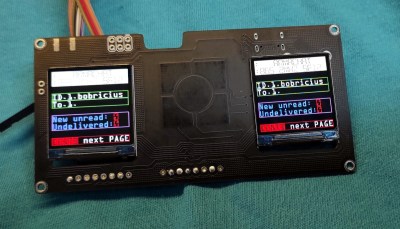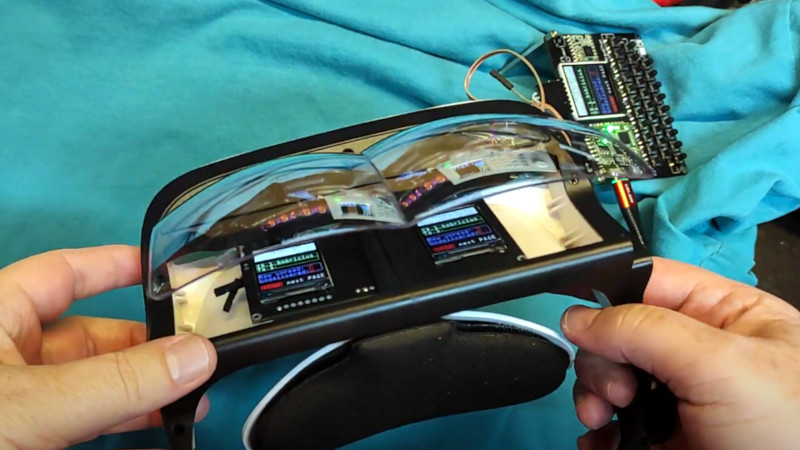Generating the real-time images required for augmented reality (AR) goggles usually requires a fair amount of processing power, to the point that DIY efforts based around the Raspberry Pi often have trouble keeping up. But what if your AR aspirations don’t require fancy high-resolution graphics? If text and the occasional icon is enough to get the job done, then these lo-fi AR goggles from [bobricius] might be the ideal solution.
As with previous homebrew AR rigs we’ve seen, this one starts with an affordable headset designed to project the display of a smartphone onto a pair of curved optical combiners. But instead of tucking a phone into the headset, [bobricius] is using a custom PCB that holds a pair of ST7789 1.3 inch 240 x 240 IPS displays. Connected over SPI and supported by just about any microcontroller you’d care to use, tossing some textual data over your field of vision can be accomplished in just a few lines of code.
 [bobricius] has actually put together a couple different versions of the PCB for this project. One uses his custom ATSAMD21E18-based “ArmaBrain” module that packs the MCU and an array of common components onto a 28 mm square board that can be easily dropped into other projects. If you’d rather roll your own solution, the second version of the board that simply holds the two displays in the appropriate position and routes the SPI lines to a convenient header should do nicely.
[bobricius] has actually put together a couple different versions of the PCB for this project. One uses his custom ATSAMD21E18-based “ArmaBrain” module that packs the MCU and an array of common components onto a 28 mm square board that can be easily dropped into other projects. If you’d rather roll your own solution, the second version of the board that simply holds the two displays in the appropriate position and routes the SPI lines to a convenient header should do nicely.
We’ve seen augmented reality displays using microcontrollers like the ESP32 before, but those were essentially just remote displays for a more powerful system. We like this simplified approach, as there are plenty of applications where just getting a few lines of text or some low-resolution images would be more than sufficient for the task at hand. Plus, the commercially-made headset this project is based on certainly looks better than some of the other donor goggles we’ve contemplated modifying in the past.


















What was the first headset, can anyone tell me the name of it?
The sword of damocles
It’s called AR Headset in Aliexpress
WTF, that video blows. It doesn’t provide any info on sourcing the components, or show the view from the goggles. This post makes me question Hackaday. Embarrassing.
https://www.aliexpress.com/item/1005001590454754.html
Hi Oscar,
Perhaps you’re new here. The first link in the article will take you to the information you seek.
Hope that helps,
Elliot.
Why would you use micro if you already have a 4 core 1.5Ghz smartphone that can run python?
Didnt know you can buy holo lens for phones.
Power drain. A simple microcontroller can run for a significantly longer amount of time on the same battery than a phone can. A microcontroller is simpler to design and program for this particular application. There’s less overhead. And it’s cheaper overall.
https://www.youtube.com/watch?v=eYmeS4N_ETw